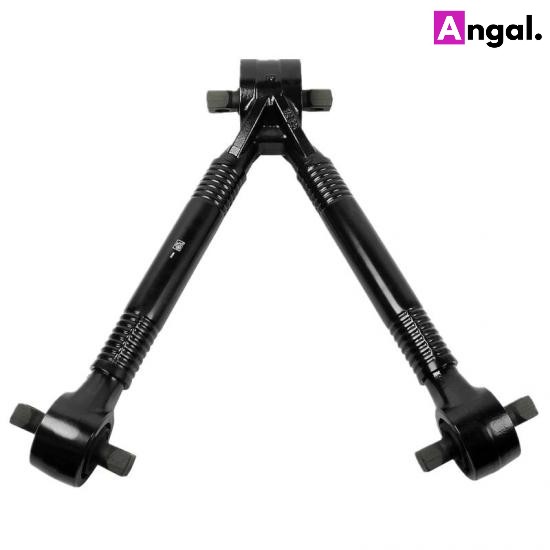MORE ABOUT V ROD ASSEMBLY :
A V rod can also be called a Wishbone ( normally used in catalogs for referencing the same) , V rods are suspension Joints that are meant to limit the movement of the axles without limiting suspension articulation. This type of suspensions are very common on medium and heavy-duty trucks and trailers.
V rods can be longitudinal or they can be transverse (running side to side). The longitudinal V Rods are often called as Torque rods or radius rods. On truck drive axles the V rods will keep the axle centered in the frame and control the driveline angles by managing the torque that is running through the driveline and the axles. On trailers, the torque arms will keep the axles centered and aligned to prevent dog-tracking and tire wear. V rods are often overlooked, but they play an important role in the longevity of suspension components and tires. They work by resisting change along the length of the assembly. The forces generated by driving down the road will pull or push on the torque rods, and they are designed to bear these stresses instead of other suspension components. Bushings in each end dampen the stresses and allow the torque rod to be mounted to the vehicle.
V ROD COMPONENTS
V rods are simple and have only a few parts. Bushing and the Shafts that holds the Bushing. The shafts are typically made from steel or aluminum with a solid or hollow construction. Most torque rods will be straight or V Shaped, but on certain suspensions, they may be purposely curved to allow clearance to suspension components.
V ROD SHAFTS
Round Shafts – The round shaft is the most common type found, and the shaft will resemble a pipe. The diameter of the pipe can vary from vehicle to vehicle. These may be solid or hollow.
Round Adjustable – Adjustable type V rods will have threads at each end that allow you to adjust the length of the rod. Both ends will be threaded oppositely so the central tube section turns; both ends will thread in and out evenly just as a tie rod tube is threaded for alignments. Lock bolts will be used on both ends to secure the ends when you are finished adjusting. Adjustable V rods are used when performing alignments on different types of truck and trailer suspensions. It is common for one side of the suspension to use solid non-adjustable rods, and the other side will use an adjustable rod.
Cast / I-Beam – Cast type V rods will be solid and resemble an I-beam in shape. The casting process will leave them with a rough surface.
V ROD BUSHINGS
The bushings located in the ends of the V Rods and One at the center usually the bigger one, are the only wear areas of the V Rod Assembly. As the vehicle moves, the bushings are absorbing the road shock to prevent damage to other suspension components. Over time the material in the bushings will wear out. When the material wears the V Rod will start to allow excess movement of the suspension components, and this may show itself as tire wear or dog tracking. In severe cases, it can cause universal joint wear or even driveline damage.V Rod bushings should be inspected for wear and excess movement during preventative maintenance. Worn bushings or damaged V Rods should be immediately replaced when issues are found.
V ROD BUSHING REPLACEMENT
We recommended that a shop perform the replacement of V rod bushings. Replacing the bushings requires a large hydraulic press and correctly sized press dies. Patience and a lot of practice aide in replacing V rod bushings and incorrectly installing bushings can easily destroy them. In some cases replacement may require a special V rod bushing tool.
SYMPTOMS OF A BAD V ROD BUSHING
Worn V rod Assembly bushings can cause several issues with the suspension, and if V rod bushings have enough wear, it may even cause damage to the suspension or driveline components. As the suspension is no longer secured in a fixed position, it may present some strange symptom .
The main issues that the vehicle will present are:
Tire wear , Clunking under acceleration and braking ,Wandering
There are only limited spare parts details available online for the complete price list and pdf catalogue of spare parts please send us your queries on your email.
